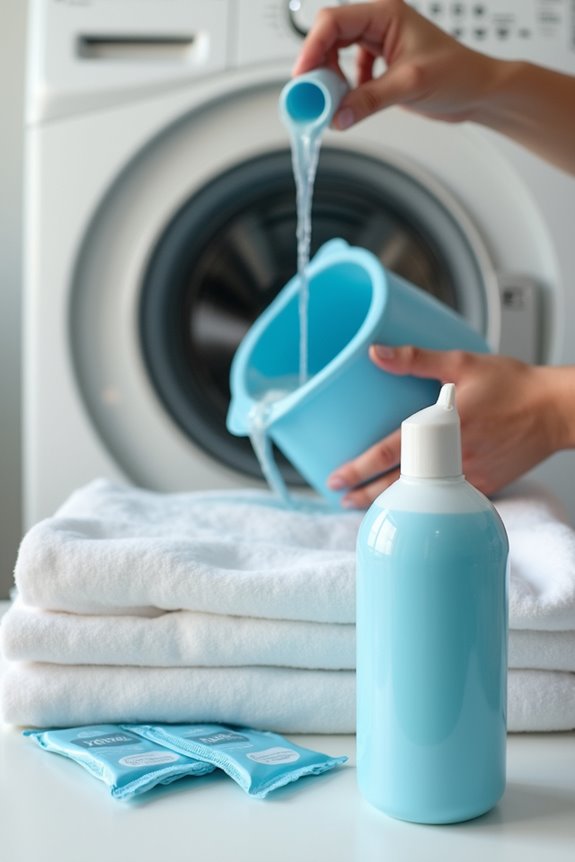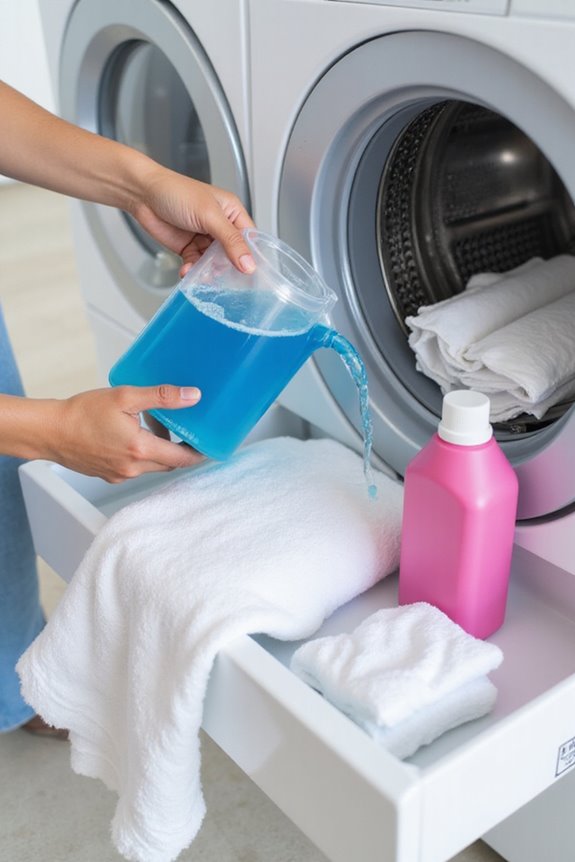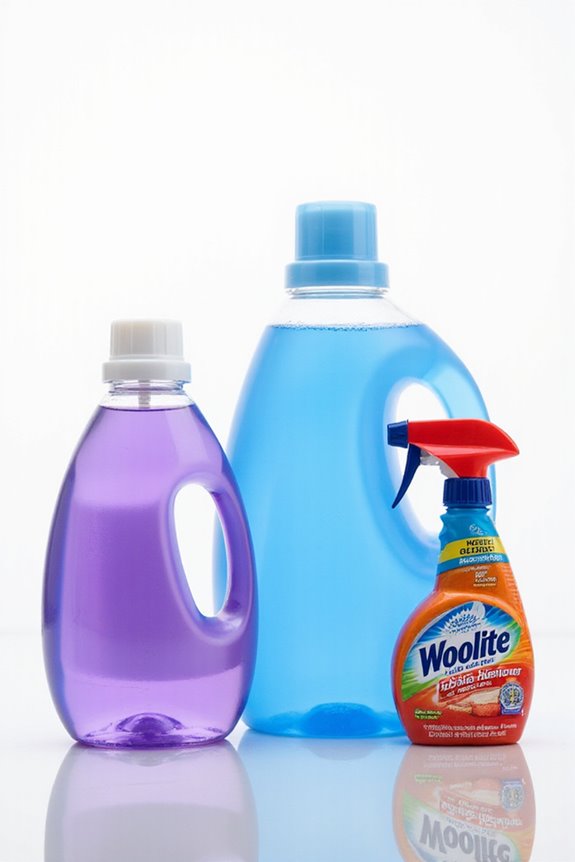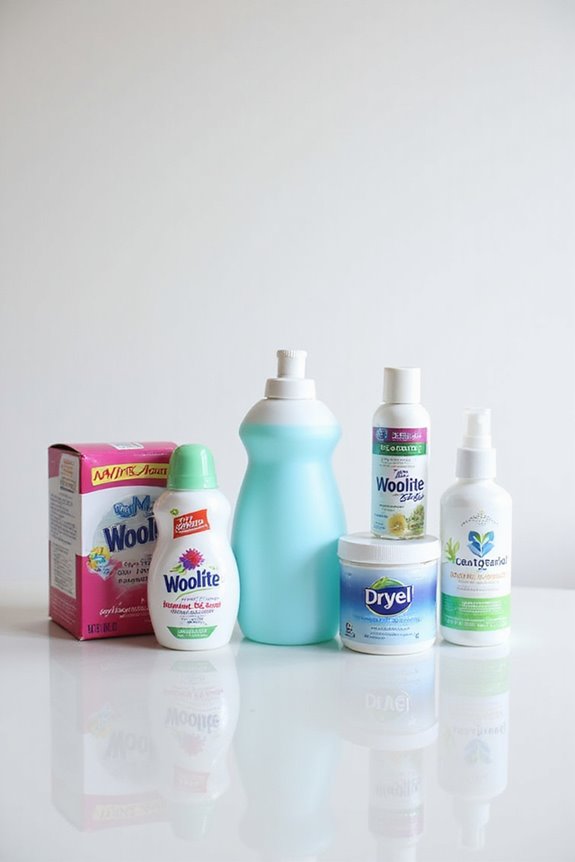Mixing fabric softener and detergent isn’t a great idea, folks. It can make your laundry less effective, leaving clothes dirty and stiff. Detergents work best on their own, breaking down stains, while fabric softeners should join the party during the final rinse. Plus, mixing them can gunk up your washing machine, leading to some unwanted problems. Want to keep your laundry fresh and your machine happy? Let’s explore better options together!
Key Takeaways
- Mixing fabric softener and detergent can lead to chemical incompatibility, reducing their effectiveness and potentially causing residue buildup on clothes.
- Adding fabric softener at the wrong time can hinder cleaning and softening, leading to the need for rewashing.
- Residue from mixing can clog washing machine dispensers and sensors, affecting performance and increasing maintenance needs.
- Fabric softener should be added during the final rinse cycle for optimal results and to avoid interference with detergent action.
- Following product guidelines helps maintain washing machine longevity and ensures cleaner, fresher laundry outcomes.
Understanding the Chemical Composition of Detergents and Fabric Softeners
When we think about laundry, we often focus on getting our clothes clean, but understanding the chemical makeup of detergents and fabric softeners can really help us use these products more effectively. For starters, detergents primarily use anionic or non-ionic surfactants as cleaning agents, which lift dirt from fabric fibers. In contrast, fabric softeners rely on cationic surfactants, acting as softening agents that bond with fabric and reduce static. These formulation differences are vital, as mixing them can lead to performance issues. Additionally, fabric softeners include emollients for lubrication, while detergents may contain enzymes for stain removal. Knowing these ingredient functions can enhance our laundry experience and keep our clothes looking their best. Moreover, choosing the right antibacterial detergent can provide an added layer of cleanliness to your laundry routine. So, let’s get to washing!
The Role of Detergents in Laundry

Understanding the role detergents play in our laundry routine can make a big difference in how clean our clothes come out. Detergents are our trusty allies, fighting dirt, oils, and stains. They contain surfactants that break down these nasties, helping to lift them from our fabrics. These surfactants have a cool trick: one end loves water, while the other loves oil, allowing them to surround and detach grime. Plus, enzymes in biological detergents tackle stubborn stains even at lower temperatures, which is great for saving energy. So, when we toss in our detergent, we’re not just washing; we’re activating powerful cleaning mechanisms that keep our clothes looking fresh. Let’s embrace the science behind our laundry! Additionally, using enzyme-powered detergents can enhance the removal of protein stains effectively.
The Purpose of Fabric Softeners

Fabric softeners play an essential role in our laundry routines, making our clothes feel softer and more comfortable. The fabric softener benefits are numerous, from reducing wrinkles to protecting fibers. For instance, they help keep our shirts looking sharp and our bedding feeling fresh. There are various fabric softener types available, including liquid versions and dryer sheets, each offering unique perks. They can even help minimize static cling, which is a game-changer for those annoying winter days. Plus, who doesn’t love that fresh scent? We’ve all noticed how fabric softeners can extend the life of our favorite clothes, making them feel cozy against our skin. Additionally, selecting the right fabric softener based on scent preference and eco-friendly ingredients can enhance your overall laundry experience. So, let’s embrace these little laundry heroes!
Why Mixing Detergent and Fabric Softener Is Ineffective

Mixing detergent and fabric softener might seem like a time-saver, but it actually creates more problems than it solves. We often think we can combine their benefits, but when we mix them, we run into chemical incompatibility. Detergents contain anionic surfactants, while fabric softeners use cationic ones. When combined, they form insoluble compounds that neutralize each other’s effectiveness. This means we lose out on detergent benefits and face softener drawbacks, like rougher fabrics and increased static cling. Plus, adding them together disrupts the washing cycle, preventing the softener from doing its job properly. So, let’s stick to using them separately for the best laundry results, shall we? Our clothes will thank us! Additionally, using a detergent with effective odor-fighting ingredients can enhance freshness and cleanliness in your laundry.
Washing Machine Design: Separate Compartments Explained

When we load up our washing machines, it’s easy to overlook just how much thought goes into their design, especially when it comes to compartments. Each compartment serves a specific purpose, enhancing compartment functionality. We often find a main detergent compartment, a pre-wash compartment for those extra dirty clothes, and even a bleach compartment for chemical additives. This design evolution prevents mixing until the right time in the wash cycle, ensuring our laundry gets the clean it deserves. Fabric softeners have their own dedicated compartment, releasing at just the right moment during the rinse cycle. It’s like a well-choreographed dance! Additionally, understanding the importance of compartment functionality can help us maximize washing efficiency. So, let’s take a moment to appreciate these clever designs that help keep our clothes fresh and clean.
The Impact of Improper Mixing on Cleaning Outcomes
It’s surprising how much impact improper mixing can have on our laundry results. When we mix fabric softener with detergent, we can face serious issues with cleaning efficiency. The chemical interactions between the two can neutralize their effectiveness, leaving our clothes less clean and not as soft. Imagine doing laundry only to find stubborn stains still clinging on! If we add fabric softener too early, it gets rinsed away before it can work its magic. We’ve all experienced that disappointment. Plus, residues can stick to our clothes, making us rewash them—what a waste of time! To get the best results, we need to stick to using these products as intended. Trust us, your laundry will thank you! Additionally, using hypoallergenic formulas can help minimize irritation risks for those with sensitive skin.
Risks to Washing Machine Performance From Mixing
Even though we might think mixing fabric softener and detergent is a quick shortcut to fresh-smelling laundry, it can actually lead to some serious headaches for our washing machines. The residue accumulation from this mix can clog dispensers and sensors, causing machine errors. Ever dealt with foam overflow? It’s not just messy; it can disrupt cycles and lower cleaning performance. Plus, increased maintenance frequency is inevitable, and we’ll likely face higher energy consumption too. Over time, that residue can even lead to odor development and mold. So, while it might seem like a timesaver, those short-term gains can cost us in repairs and machine lifespan. Let’s keep our washers happy and stick to the guidelines!
The Emergence of 2-in-1 Detergent and Softener Products
As we juggle our busy lives, who wouldn’t want a laundry solution that combines cleaning and softening in one go? The emergence of 2-in-1 innovations has been a game changer. These products cater to our need for consumer convenience, especially in urban areas where time is precious. Market growth shows that more folks are turning to these eco-friendly formulations, making them a smart choice. Thanks to technological advancements, brands like Tide Plus A Touch of Downy have mastered product versatility, blending detergent and softener seamlessly. Packaging solutions, like pods, make it easier than ever. We see commercial adoption rising too, as businesses enjoy the efficiency these products bring. It’s clear: 2-in-1 options are here to stay!
Practical Tips for Using Detergent and Fabric Softener
Have you ever wondered how to get the best results from your laundry routine? To start, let’s choose the right detergent types. It’s best to match our detergent with the fabric we’re washing. For instance, some detergents work better on delicate fabrics, while others excel on tougher stains. When using fabric softener, remember its benefits: it softens clothes and reduces static. But we should avoid using it on towels and sportswear—those need to stay absorbent! Timing is essential, too; adding softener in the final rinse cycle maximizes its effect. And let’s not forget—mixing detergent and softener can actually reduce their effectiveness, so keep them separate for cleaner, fresher clothes. Happy washing!
Alternatives to Mixing: Choosing the Right Products
When it comes to laundry, we all want the best results without the hassle of mixing products that could cancel each other out. So, let’s consider some eco-friendly options! Wool dryer balls are a fantastic alternative; they soften fabrics naturally and cut drying time by about 10 minutes. Plus, we can add essential oils for a lovely scent.
Another great choice is vinegar. Adding half a cup during the rinse cycle acts as a natural fabric softener, breaking down residues and neutralizing odors. Baking soda is also a winner—it regulates pH levels and removes odors, making our clothes more invigorating. By opting for these natural alternatives, we can keep our laundry routine simple and eco-conscious. Now, isn’t that a revitalizing thought?
Frequently Asked Questions
Can Mixing Detergent and Softener Damage My Washing Machine?
Mixing detergent and softener can indeed lead to detergent buildup in our washing machines. To maintain our machines, we should always use the correct compartments and follow manufacturer guidelines to avoid potential issues and guarantee longevity.
How Do I Know if My Fabric Is Compatible With Softener?
When we consider fabric types and their compatibility with softener properties, we should read care labels, notice symbols, and understand that certain materials, like delicates and synthetics, may not benefit from softeners at all.
Are There Any Natural Alternatives to Fabric Softeners?
If we’re looking for natural alternatives to fabric softeners, vinegar’s a great option. It softens fabrics and eliminates odors, while baking soda neutralizes smells and enhances softness, making our laundry more eco-friendly and budget-friendly.
Can I Use Fabric Softener on All Types of Fabrics?
We can’t use fabric softener on all fabric types. Some may benefit, while others, like athletic wear and towels, face negative softener effects, reducing absorbency and performance. Always check care labels before applying.
How Can I Prevent Static Without Fabric Softener?
To prevent static without fabric softener, we can use dryer balls, which absorb moisture and soften fabrics. Additionally, anti-static sprays are great options for combating clingy clothes, keeping our laundry fresh and static-free.






